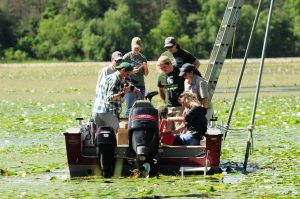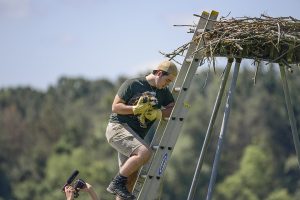This June, staff at the Kellogg Bird Sanctuary worked with the Michigan Department of Natural Resources (MDNR) to band juvenile Osprey. Osprey populations are in recovery after being disrupted by DDT in the 1960s. DDT, a chemical used for agriculture, lead to thin, weak eggshells from bird species like the Bald Eagle, Peregrine Falcon, and Osprey. Ultimately, these weak eggs were unable to hatch. However, efforts have been made that have helped the populations become healthy once again.
The MDNR now builds platforms in secluded bodies of water to help further population growth. These platforms stand approximately 10-15 feet above the water, and have a wooden base for the birds to nest on. These platforms decrease the chance Osprey will nest on cell towers and increase the chance they will nest in their more natural habitat.
Sanctuary staff went with the MDNR to band the three juvenile Osprey in the nest, and collect blood samples to determine the sex of each juvenile. After the sex of each of the three juveniles is determined, the males will be monitored with a GPS backpack to track their migration pattern.
We look forward to seeing great results from this partnership!
Brendan Kokx
Avian Intern



A legacy of conservation; a commitment to sustainability.
Kellogg Bird Sanctuary12685 East C Avenue
Augusta, MI 49012
Phone: (269) 671-2510 birdsanctuary@kbs.msu.edu